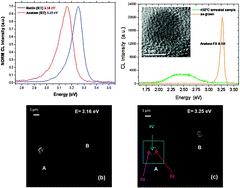Excitonic recombination in superstoichiometric nanocrystalline TiO2 grown by cluster precursors at room temperature
Abstract
Unprecedented room temperature excitonic emissions are achieved from TiO2

* Corresponding authors
a
Institute for Electronics and Magnetism, National Research Council, Parco Area delle Scienze 37/A, 43124 Parma, Italy
E-mail:
giancarlo.salviati@imem.cnr.it
b Institute for Electronics and Magnetism, National Research Council, via alla Cascata 56/C, 38123 Povo, Italy
c Institut fur Physik, Humboldt-Universitat zu Berlin, Newtonstrasse 15, 12489 Berlin, Germany
d Physics Department, University of Trento, via Sommarive 14, 38123 Povo, Italy
Unprecedented room temperature excitonic emissions are achieved from TiO2

 Please wait while we load your content...
Something went wrong. Try again?
Please wait while we load your content...
Something went wrong. Try again?
F. Detto, N. Armani, L. Lazzarini, T. Toccoli, R. Verucchi, L. Aversa, M. V. Nardi, B. Rossi, G. Salviati and S. Iannotta, Phys. Chem. Chem. Phys., 2012, 14, 5705 DOI: 10.1039/C2CP40120G
To request permission to reproduce material from this article, please go to the Copyright Clearance Center request page.
If you are an author contributing to an RSC publication, you do not need to request permission provided correct acknowledgement is given.
If you are the author of this article, you do not need to request permission to reproduce figures and diagrams provided correct acknowledgement is given. If you want to reproduce the whole article in a third-party publication (excluding your thesis/dissertation for which permission is not required) please go to the Copyright Clearance Center request page.
Read more about how to correctly acknowledge RSC content.
 Fetching data from CrossRef.
Fetching data from CrossRef.
This may take some time to load.
Loading related content
